 |
June 2010
|
June 2010 // Volume 48 // Number 3 // Feature // v48-3a4
The First 4 Years of a Warmwater Recreational Pond Management Web Site in Arkansas
Abstract
A farm pond management Web site in Arkansas was evaluated over the first 4 years of implementation in order to 1) examine usage trends, and 2) characterize clientele visiting the Web site. The Web site tallied over 30,000 visits. April and May were the peak months of activity, and surges in use followed promotional activities. Pond management characteristics of respondents to an online survey and implications to Extension education are presented. Overall, the Web site was effective in communicating to stakeholders and may be a preferred alternative to traditional Extension media.
Introduction
There are at least 2.6 million small artificial water bodies in the United States (Smith, Renwick, Bartley, & Buddemeier, 2002), most of which are located in central and southeastern states (Flickinger, Bulow, & Willis, 1999). Ponds and small impoundments are generally defined as waters larger than 0.4 ha and less than 40 ha in surface area (Flickinger, Bulow, & Willis 1999). These resources are often privately owned, and are built for a variety of reasons, including recreation, irrigation, water for livestock, and aesthetics. Fishing is a major use of ponds, and pond owners are continuously in need of timely science-based recommendations for managing these systems.
Historically, county Cooperative Extension educators were widely recognized as the key source of information for farm pond management (Kraft, 2004). However, increased specialization of Cooperative Extension personnel and changes in the structure of individual states' programs have reduced landowner reliance on county-level educators for pond management advice (e.g., Schmidt, Swistock, & Sharpe, 2003).
The general public and county Cooperative Extension agents are increasingly turning to the Internet for information. Web-based resources are becoming a primary tool for dissemination of pond management information and offer a conduit for communication between Cooperative Extension specialists, agents, and clientele. The Internet provides the advantages of being able to address current topical issues quickly, to reach a larger audience, and to be accessible at the client's convenience. In this evaluation, the first 4 years of a Web-based pond management site in Arkansas are described.
Background
The Arkansas Pond Management Web site (hereafter the Web site) was designed and built by the author to provide easy home and at-work access to up-to-date pond management information for pond owners and quick-access resource for county Cooperative Extension agents. Design of the Web site began during the early spring of 2004, and the site was fully operational and made available to the public at the beginning of May the same year. The Web site consists of a centralized home page <http://www.uaex.edu/wneal/Pond_Management/>, with links to all categories of pond construction, permitting, stocking, management, and troubleshooting information. Much of the information is housed on the Web site itself, and some links lead to external Web sites containing specialized information (e.g., plant identification).
Although the Web site is housed on the University of Arkansas Cooperative Extension Service (UACES) server, it differs from similar Web sites in other states in that it is a stand-alone site that is not embedded within a larger Cooperative Extension Web framework. At the time of writing this article, the Web Site was the number one return on both Google and Windows Live Search using a simple Web search with the key words "farm pond management," indicating that it was easy to locate for clients searching the Web for pond management information.
Objectives/Methods
The goals of this evaluation were:
- To examine the temporal trends in Web site usage associated with time of year and major events related to the Web site.
- To examine the qualitative characteristics of the clientele visiting the Web site.
Web hit information was collected from the Web site for 4 years. A standard hit counter was installed on the Web Site home page during construction that identified the number of visits to the home page. The cumulative number of hits was recorded on the last day of the month every month beginning in September 2004 and continued over the 4-year assessment period.
Additionally, a voluntary survey was used to collect qualitative information on visitors over a 1-year period. When visitors clicked on the survey link, they were redirected to the survey center on the UACES server. The survey required about 5 minutes for completion, and responses were anonymous. Location data (country, state, and county) were collected from all respondents, and they were asked if they owned or managed a pond. A response of "yes" directed them to a series of questions regarding their ponds (e.g., How many ponds, size, primary purpose, management goals, weed or other pond problems). A response of "no" directed them past the pond questions to questions regarding the Web site (e.g., visit history, Web site impact on management, suggested improvements). Questions consisted of pull-down menus, yes/no selection, multiple-choice, fill-in blank, and short-answer. Because it was a voluntary survey, respondents were not randomly selected, and therefore the survey provides a qualitative snapshot of willing participants.
Results
Web Site Usage During Evaluation
The Web site received over 31,000 hits during the first 4 years, with progressively increasing hit frequency in successive years (Figure 1). Monthly hits peaked at 509 in May 2004 and doubled to 1,021 in June 2005. The highest recorded number of hits occurred in April 2008, with 1,361 individual hits recorded. On average, April was the Web site's busiest month (mean = 907, SE = 178), followed by May (mean = 899, SE = 174) and June (mean = 859, SE = 129). November was the lightest month for Web hits (mean = 348, SE = 78), followed by December (mean = 410, SE = 37).
Figure 1.
Web Site Hit Data for the
Arkansas Farm Pond Management Web Site and Major Events Influencing
Web Site Usage
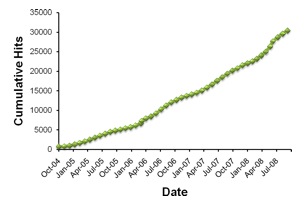
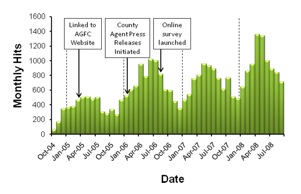
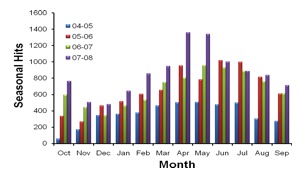
The Web site was linked to the Arkansas Game and Fish Commission's (AGFC) Web site in April 2004. In January 2006, a farm pond press release series was initiated that provided topic-oriented articles for county agents that could be submitted to local media outlets. These articles directed readers to the Web site for additional information, and reinforced the Web site's value to Country Agents. No other media were used to publicize the Web site.
Responses to Online Survey
There were 342 voluntary survey respondents from 2007-2008, representing 3.3% of the total hits during that time. Only 10 (2.6%) respondents were from outside the U.S. (Canada, Saudi Arabia, Pakistan, India, Costa Rica, and Barbados); the rest were from 37 different states. Nearly one-third (30.5%) of U.S. respondents were from Arkansas, 6.7% from Ohio, 5.2% from Texas, 4.7% from Alabama, 4.0% from Tennessee, and 3.7% each from Georgia, Kansas, and Missouri. Most (92.3%) were visiting the Web site for the first time.
When asked if they owned or managed a pond(s), 309 (91.4%) respondents answered "yes," and 29 (8.6%) respondents answered "no." The mean (SE) number of ponds managed was 1.53 (0.06) ponds, and the majority (62.3%) of ponds managed were less than 0.40 ha (1 acre) in surface area. Fishing was the most frequently cited (67.9% of respondents) primary use of ponds, followed by aesthetic beauty (14.1%) and water for livestock (7.7%) (Figure 2). A balanced bass-bluegill fishery was the most cited (61.7%) desired management option for fishing ponds, followed by trophy bass (13.2%) and catfish-only (6.8%) options.
Figure 2.
Primary Pond Usage and Primary
Fish Management Goal/Option Reported by Survey Respondents
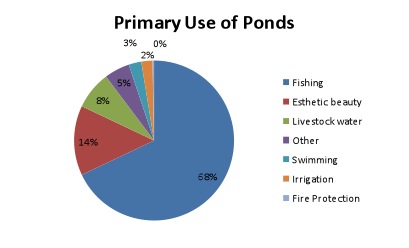

Aquatic weed problems were noted by 54.8% of respondents. Algae were the predominant (44.8%) problem plant reported (Table 1), with filamentous algae and Chara mentioned specifically. Emerged, free-floating, and submerged plants were reported less frequently at similar percentages. A plurality (47%) of respondents who reported aquatic weed problems were not currently implementing control methods (Figure 3). Biological, chemical, and physical control, as well as integrated approaches
| Plant Growth Form | Number of Respondents | Species Listed by Name (scientific name) | Number of Reports | Percent |
| Algae | 73 | 44.8% | ||
| Muskgrass (Chara spp.) | 3 | |||
| Filamentous algae (ex. Pithophora spp.) | 4 | |||
| Emergent | 28 | 17.2% | ||
| Pondweeds (Potamogeton) | 4 | |||
| Cattails (Typha spp.) | 3 | |||
| Water lilies (Nymphaea spp.) | 5 | |||
| Watershield (Brasenia schreberi) | 1 | |||
| American lotus (Nelumbo lutea) | 2 | |||
| Water primrose (Ludwigia spp.) | 1 | |||
| Water willow (Salix nigra) | 1 | |||
| Free-floating | 30 | 18.4% | ||
| Water hyacinth (Eichhornia crassipes) | 1 | |||
| Duckweeds (Lemnaceae) | 4 | |||
| Watermeal (Wolffia spp.) | 4 | |||
| Submersed | 32 | 19.6% | ||
| Coontail (Ceratophyllum demersum) | 1 | |||
| Water milfoil (Myriophyllum spp.) | 2 | |||
| Hydrilla (Hydrilla verticillata) | 1 |
Figure 3.
Percentage of Respondents Who
Answered "Yes" to Having an Aquatic Weed Problem that
Reported Using Biological, Chemical, Physical, Integrated
(Combination), or No Weed Management Approach
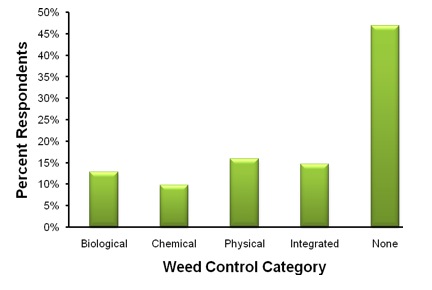
Respondents were asked to select other pond problems that they were experiencing from a list of common issues. Turbid water was the most common pond issue after weeds, indicated by 27.1% of respondents. Stunted bass (Micropterus spp.; 21.9%), leaky ponds (19.7%), and crappie (Pomoxis spp.) present in pond (14.8%) were the leading problems after turbidity (Figure 4). Individuals who indicated that their ponds contained crappie did not necessarily indicate that they considered crappie to be a problem. Respondents who indicated undesirable species listed bullheads (Ameiurus spp.; 11 times), large grass carp (Ctenopharyngodon idella; 4 times), golden shiners (Notemigonus crysoleucas; 2 times), bream (Lepomis spp.; 2 times), bass (2 times), crappie (2 times), chain pickerel (Esox niger; 1 time), green sunfish (Lepomis cyanellus; 1 time), leeches (1 time), snakes (1 time), and snapping turtles (1 time). Somewhat surprisingly, fish kills (8.1%) were the least common issue reported.
Figure 4.
Percentage of Respondents Who
Answered "Yes" to One or More of the Listed Common Pond
Problems
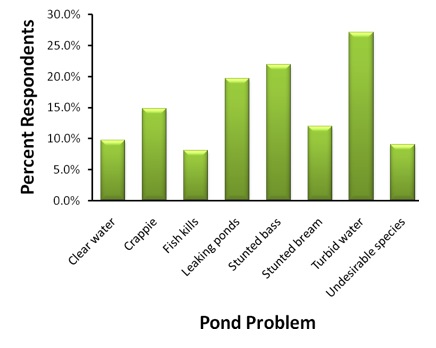
When queried on the usefulness of the information provided by the Web site, 83.4% of respondents answered "yes" to the question, "Has the Web site improved your understanding of ponds?" Eighty percent of pond owners indicated that "the Web site provided useful information that has improved [their] pond." The respondents were then asked an open-ended question about how they have modified or will modify their pond management based on information provided by the Web site. Liming (4), reduced stocking rates (compared to those suggested by fish suppliers) (2), aeration (2), and turbidity remediation (2) were the most commonly listed changes. Unfortunately, many respondents indicated that they took the survey prior to thoroughly reviewing the Web site and formulating management plans.
Additional topics for the Web site that were suggested by respondents were grouped into nine categories. More information on pond aquaculture and fee fishing was indicated most frequently (4 respondents), followed by pond repair (levees, leaks, dredging) (3), specific weed control recommendations (2), and more detailed construction information (2). Aesthetic improvement guidelines, more detailed instructions for lime application, fish habitat improvement, and drought management were each suggested once.
Discussion
Web-based resources are becoming an important source of information for stakeholders and Cooperative Extension personnel. Fiscal restraints, the need for rapidly updated information, and the ease and breadth of electronic information delivery have made Web-based resources more desirable than many traditional sources of written communication. Written publications are increasingly costly to print, store, and mail (Jones, 1990). Furthermore, written publications can spread out-of-date information because older versions are not always destroyed when replaced by updated materials (Shaffer & Hussey, 1992). Although using electronic media is no longer a novel approach, Web-based Extension is still developing, and many aspects of its relative benefits have yet to be explored (Muske, Goetting, & Vukonich, 2001). For instance, Web sites may reduce email and phone requests for print material and one-on-one consultations, while simultaneously expanding the audience in terms of size and diversity. Further research on these aspects of Web-based delivery is recommended.
Web Site Usage Patterns
The Web site evaluated in the study reported here effectively reached large numbers of stakeholders and Extension personnel. During the 2007-2008 evaluation year for example, 10,360 visits to the homepage were recorded. While some of these visits may have been repeat visits by pond owners or Cooperative Extension agents, clearly a large number of stakeholders used this resource. Anecdotally, the author noted a distinct increase in email contacts following the establishment of the Web site, with many directly referencing the Web site in their communications.
Similar to a pond Web resource evaluation from New York (Kraft, 2004), there was a distinct seasonal pattern of high Web site use during warmer months and lower use during cooler months. It is probably no coincidence that November was the month of lowest use, as many stakeholders turn their attention to wildlife management and hunting at that time of the year. Although each study measured a different metric, it is interesting that peak visitation in this evaluation (April and May) occurred 2 months before peak user inquiries (questions submitted to the Web site) to the similar Web resource in New York (Kraft, 2004). This was likely due to the geographical latitude that each Web site primarily supports, because New York ponds are usually still under ice cover when pond management season begins in Arkansas.
It is unclear to what extent Web site promotion and linkage contributed to the growth in Web site usage, but the number of hits doubled 1 year after linkage with the AGFC Web Site and several months after the initiation of Cooperative Extension agent press releases. Many pond owners use AGFC as their source of information, and it is reasonable to attribute some of the increases in hits to that exposure, but the bulk of the Web site's expansion followed the implementation of press releases. The first press release, in fact, was an announcement of the Web site and the information it contains. Subsequent press releases usually cited the Web site as a source of additional information.
Characterization of Web Site Clientele
It is important to clarify again that the survey instrument used in this evaluation was not a quantitative instrument due to its voluntary nature. However, the information gained from this survey can be used to qualitatively characterize stakeholder issues and provide some feedback on the Web site's efficacy. While the data collected may or may not be an accurate representation of the views of all pond owners, it does characterize the more enthusiastic Web site users who were willing to participate.
It was not surprising that the majority of respondents were from the Southeastern U.S., given the regional nature of most pond management recommendations. It was somewhat surprising, however, that two-thirds of respondents were from outside of Arkansas, when no attempts were made to advertise outside of Arkansas markets. This finding suggests that there is a need for similar Web-based resources in other states, because those stakeholders are clearly seeking out information wherever it can be found. While it is true that most states have available Web-based Extension information, this information may not always be easy to locate.
The high out-of-state usage presents an interesting conflict. The farm pond recommendations promoted by the Arkansas Cooperative Extension Service may not necessarily be the same as those promoted within the state of the stakeholder and may not be appropriate or legal in other states. For example, threadfin shad and Florida largemouth bass are included in trophy bass management recommendations in Arkansas, but both species would not survive under extended ice cover to the north. Grass carp are recommended for weed control in Arkansas, but only sterile grass carp are allowed in some states, and the fish are illegal altogether in others. The Web site needs to make it clear to out-of-state visitors that they should check with their own state's Cooperative Extension Service to ensure the best management for their pond. In addition to such a disclaimer, a link to the USDA CSREES Website with an index of state Extension program Web pages would facilitate information delivery.
Pond Management by Respondents
Most respondents owned or managed a pond. The remainder may have been considering building a pond, may use ponds that they don't own or currently manage, or may have been simply curious. Of those who owned or managed a pond, two-thirds reported that fishing was the primary use of the pond and that a balanced bass-bream fishery was the most desired management option. Trophy bass management was commonly cited, but surprising only 1% of respondents cited trophy bream fishing as their management goal.
Not surprising was that 5% of respondents listed quality crappie as their most desired species management goal, despite the substantial evidence to the effect that crappie are detrimental species for small impoundments (e.g., Farquhar, 1982; Cichra, Noble, & Farquhar, 1984). Crappie are a primary sport fish nationwide, accounting for 21% of all freshwater angling days (USDI & USDC, 2001). Many Cooperative Extension programs, including in Arkansas, have invested much effort into discouraging crappie in ponds, but the demand continues, and the author's personal experience suggests that the percentage of pond owners who would stock crappie in their ponds if recommended is very high. Many stock crappie regardless of the warnings. Perhaps it is time to take a new look at crappie in ponds, particularly focusing on manipulating predator-prey relationships and alternative predators.
Aquatic weeds are often cited by Cooperative Extension agents (personal communications) as the most common pond issue that their stakeholders have, and the respondents to the Web Site survey were no different. More than half of respondents reported some form of aquatic weed problem in their ponds, and nearly 45% of the time the problem plant was a type of algae. It was suggested by respondents that the Web site needed to have more specific weed management recommendations. This suggestion can probably be expanded to most Cooperative Extension materials on the subject of weed control, which often erroneously assume that the stakeholder will know how to "fill in the blanks." Perhaps we need more cookbook-style recommendations listed for each common weed species.
Conclusions
The Web site has been a valuable resource for pond managers and Extension personnel. Web-based resources may be superior to traditional Extension materials in respect that they are readily accessible, can be updated frequently, and are without (direct) cost. However, as Kraft (2004) points out, Web-based resources are only as good as the information provided, and a conscious effort must be made to keep these resources up-to-date. Furthermore, periodic marketing is required to inform stakeholders of these resources. With proper development, marketing, and upgrades, Web-based farm pond information delivery can play a valuable role in Extension education.
Acknowledgments
Web site creation and data collection for this evaluation were conducted while the author was employed at the University of Arkansas at Pine Bluff (UAPB), and many members of UAPB's Cooperative Extension Program provided helpful insight during Web site development. The author would like to specifically thank C. Hutt and N. Stone for help in design of the survey instrument. W. Lewis was instrumental in survey implementation and data collection. B. West and C. Hutt provided manuscript guidance while the manuscript was in draft.
References
Cichra, C. E., Noble, R. L., & Farquhar, B. W. (1984). Relationships of white crappie populations to largemouth bass and bluegill. Proceedings of the Annual Conference Southeastern Association of Fish and Wildlife Agencies 35(1981):416-423.
Farquhar, B. W. (1982). Evaluation of striped bass Χ white bass hybrids in small impoundments. Annual Proceedings of the Texas Chapter, American Fisheries Society 4:55-66.
Flickinger, S. A., Bulow, F. J., & Willis, D. W. (1999). Small impoundments. Pages 561-588 in C. C. Kohler and W. A. Hubert, editors. Inland fisheries management in North America, 2nd edition. American Fisheries Society, Bethesda, Maryland.
Jones, P. (1990). Producing a CD-ROM: Preparation of Extension publications. CD-ROM EndUser 2:14-16.
Kraft, C. (2004). Pond management: An evaluation of Web-based information delivery. Journal of Extension [On-line] 42(1) Article 1FEA3. Available at: http://www.joe.org/joe/2004february/a3.shtml
Muske, G., Goetting, M., & Vukonich, M. (2001). The World Wide Web: A training tool for family resource management educators. Journal of Extension [On-line], 39(4) Article 4FEA3. Available at: http://www.joe.org/joe/2001august/a3.html
Schmidt, K. L., Swistock, B. R., & Sharpe, W. E. (2003). Distance education of Pennsylvania pond owners. Journal of Extension [On-line] 41(4) Article 4RIB2. Available at: http://www.joe.org/joe/2003august/rb2.shtml
Shaffer, D. L., & Hussey, G. A. (1992). PENpages: Sharing agriculture and Extension information internationally through the Internet. Quarterly Bulletin International Association Agricultural Information Specialists 37:97-101.
Smith, S. V., Renwick, W. H., Bartley, J. D., & Buddemeier, R. W. (2002). Distribution and significance of small, artificial water bodies across the United States landscape. The Science of the Total Environment 299:21-36.
USDI & USDC (U.S. Department of the Interior, Fish and Wildlife Service & U.S. Department of Commerce, U.S. Census Bureau). (2001). 2001 National Survey of fishing, hunting, and wildlife-associated recreation. U.S. Government Printing Office, Washington, D.C.




